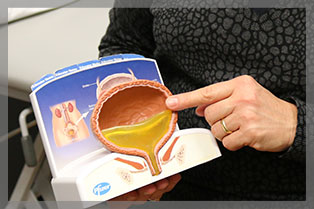 Bladder incontinence is the involuntary loss of urine. It is not a disease, but a symptom of a physical or neurological problem. It is estimated that up to 25% of adults have urinary incontinence and that women are affected twice as often as men. Although the chance of becoming incontinent increases with age, it happens to people of all ages and is NOT a natural part of aging.
Bladder incontinence is the involuntary loss of urine. It is not a disease, but a symptom of a physical or neurological problem. It is estimated that up to 25% of adults have urinary incontinence and that women are affected twice as often as men. Although the chance of becoming incontinent increases with age, it happens to people of all ages and is NOT a natural part of aging.
Symptoms can include:
- Leaking urine or stool when you sneeze, run, exercise, laugh, cough… (Stress urinary incontinence)
- Problems getting to the bathroom in time (urgency)
- Constipation
- Frequent need to urinate
The bladder is a hollow muscular organ that collects urine. Urine leaves the bladder through the urethra, a narrow tube-like structure extending from the bladder to the outside of the body. The bladder has two functions. It either stores urine or empties urine. During the storage phase the bladder muscle remains relaxed, while the sphincters and muscles that block off the urethra and bladder stay contracted, thus preventing any urine from escaping. If urine escapes during the storage phase, it is called a leak.
Urine leakage, or incontinence, can have many causes.. Stress and urge are two common types of urinary incontinence. Many people have more than one type of incontinence at the same time.
STRESS INCONTINENCE
Many people leak urine when they cough, sneeze, walk, run or otherwise exert themselves. This is called stress urinary incontinence. These actions increase the pressure within the abdomen. This increased pressure squeezes the bladder. If the pressure squeezing the bladder is greater than the closure pressure of the sphincters sealing the urethra, urine is forced out and a leak occurs. Correctly performed pelvic floor muscle (Kegel) exercises can help stop this leakage. Research shows that based on verbal and written instruction, 75% of women are doing these exercises incorrectly.
URGE INCONTINENCE
A strong, sudden need to empty the bladder is called urgency. When it is associated with leakage it is called urge incontinence. Remember, the bladder is a muscle. The strong urge is caused by an overactive contraction of the bladder muscle. The problem is compounded if the pelvic floor muscles that close the urethra and bladder are weak. Several things can cause your bladder to become overactive. Small bladder capacity, nerve damage, caffeine, and anxiety are a few of the contributors to an overactive bladder. It is not uncommon for someone to have both stress and urge incontinence. The individual can learn to suppress the urges, increase their bladder capacity and the amount of time between emptying their bladder, and strengthen their pelvic floor muscles. There are also medications that can help the bladder to be less active.
Treatment varies depending on the problem. At Dayan Physiotherapy, we use both Real Time Ultrasound and Biofeedback to help you learn how to contract and strengthen your pelvic floor (Kegels). Research shows that up to 75% of women, based on verbal and written instruction alone, are doing Kegels (contracting their pelvic floor) incorrectly. We do not have the research for men, but our clinical experience shows it to be about the same. We also help you learn behavioural changes involving diet and toileting patterns and, prescribe the use of internal assistive devices (pessaries) to help you regain control of your bladder.
